System in the 1 Java Street mixed-use development in Brooklyn is set to be largest in the state—and possibly the U.S.—when the project opens in 2025
https://www.enr.com/articles/56786-nyc-project-touts-record-for-residential-geothermal-heating
By Tom Stabile
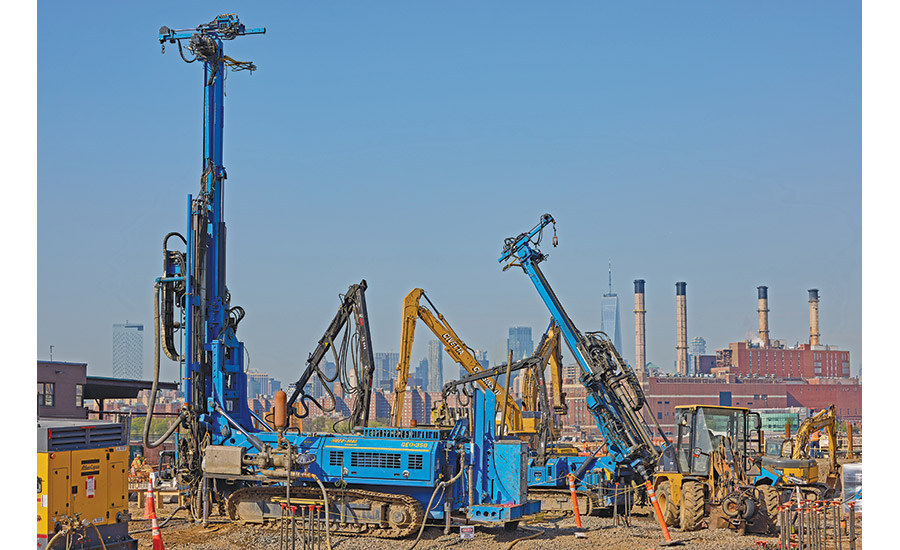
Photo by David Joshua Ford, courtesy Lendlease
July 13, 2023
Drilling rigs are punching the last of 320 boreholes this summer on a full city block along the East River, where Lendlease is building a 789,000-sq-ft mixed-use complex of five buildings in Brooklyn’s Greenpoint neighborhood. While no one will see the 499-ft-deep holes when 1 Java Street opens in late 2025, they underpin the development’s signature feature as the largest residential geothermal system installed in New York state, and possibly in the U.S.
Situated on a 2.6-acre waterfront site, the five complex buildings will be connected—including a 37-story showpiece on stilts—that will house 834 apartments, 13,000 sq ft of retail, 27,000 sq ft of amenities, 276 parking spaces, a waterfront esplanade and a host of sustainable features.
Underneath it all will be geothermal technology allowing the complex to use solely electric power—two years ahead of a 2027 New York City mandate—and slash its carbon emissions profile.
The geo-exchange system at 1 Java Street—which this year won $4 million from a New York State Energy Research and Development Authority (NYSERDA) pilot program—would cut annual heating and cooling emissions by 53% compared with traditional natural gas boilers and cooling towers, or by 1,050 metric tons of carbon dioxide.
The project will also meet Lendlease’s own “mission zero” corporate goal to pursue all-electric heating and cooling and avoid fossil fuels, says Scott Walsh, project director for New York development at the Australia-based contractor and developer. “This is a groundbreaking project for the U.S., just given its size and complexity. It will have a really significant sustainability and socially responsible foundation,” he says.
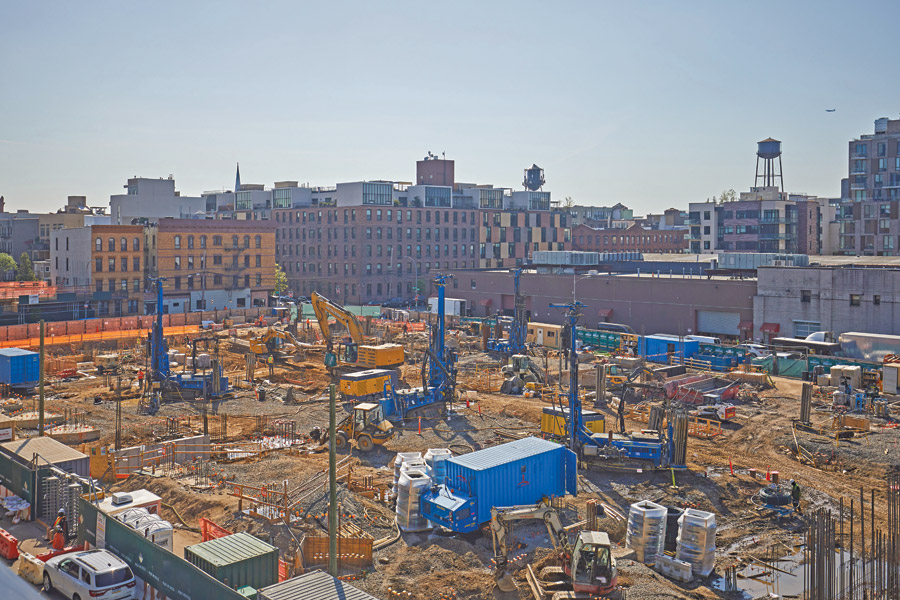
Situated on a 2.6-acre site in Brooklyn’s Greenpoint neighborhood, 1 Java Street will consist of five different, connected buildings, the tallest of which will be 37 stories.
Photo by David Joshua Ford, courtesy Lendlease
The project will be a showcase for geothermal technology, says Zachary Fink, president of ZBF Geothermal, which is consulting on 1 Java’s system. “The fact that we have a well-known multinational developer installing geothermal on a building that will change the Brooklyn skyline … makes it easier for other developers to make the investment decision,” he says.
Local geothermal systems are critical to a clean energy transition, according to Donovan Gordon, NYSERDA director of clean heating and cooling. “Community thermal networks are an important step in scaling building electrification,” he said in a Lendlease press release.
“The fact that we have a well-known multinational developer installing geothermal on a building that will change the Brooklyn skyline … makes it easier for other developers to make the investment decision.”
—Zachary Fink, President, ZBF Geothermal
The system, which will supply all heating and cooling needs for 1 Java’s building interiors and water, will be the state’s largest based on project square footage, building height, number of residential units and borehole count, according to Lendlease. The vertical closed-loop system will circulate a water-based liquid through subterranean pipes that the earth will heat or chill depending on the season, as below-ground temperatures in winter are warmer than surface air and cooler in summer. A heat pump will use that temperature differential to help warm or cool the building.
While 1 Java’s groundbreaking took place in April, geothermal system work began in 2021 with feasibility testing, Fink says. The project team has dug more than 75% of its boreholes this year and is on track to finish this summer, while also tackling other foundation work.
“All of the pile-driving and caissons and the foundations for the shear wall is complete,” Walsh says. “As we get into the summer, the slabs get poured, and then the site will start to go vertical.”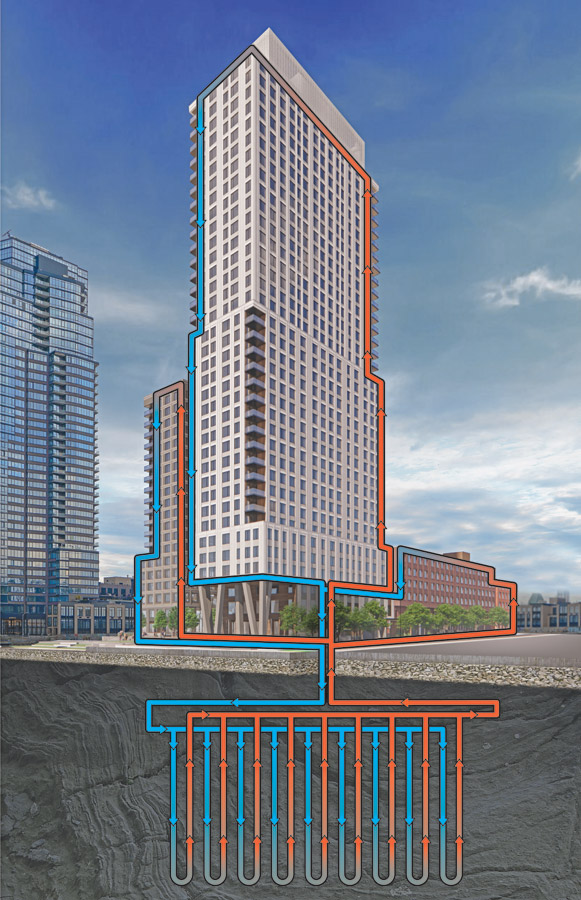
A geothermal ground source heat pump system uses the stored temperature in the ground to heat and cool the building.
Rendering courtesy of Lendlease and Marvel
Pandemic Redirection
Lendlease and its joint venture equity partner Aware Super, an Australian pension fund, acquired the Greenpoint site for $111 million in late 2020 from a RedSky Capital affiliate and JZ Capital. At the time, Lendlease outlined a $660-million effort and has not since updated the figure.
While the previous developers had commissioned a Skidmore, Owings & Merrill design, “Lendlease elected to take a fresh look” and selected Marvel as architect, Walsh says.
In addition to 37- and 20-story towers on its western edge, the site will have a 10-story building facing India Street on the east and six-story buildings on the 600-ft-long Java and West cross streets.
Planned amenities include a rooftop pool and decks, interior courtyard, fitness center, work lounges and a children’s playroom. The public waterfront esplanade will connect to the India Street Pier, which includes a NYC Ferry landing.
The site also will feature landscaping planned by James Corner Field Operations, a lobby and amenity interiors designed by INC and townhouse interiors designed by Crème. Other design team members include Arup as MEP engineer, McNamara Salvia as structural engineer and Langan as geotechnical engineer.
The developers are designating 251 apartments, or 30%, as affordable housing. By starting work in 2022, the project qualified for a tax abatement under the state’s current affordable housing program before it expired, Walsh says.
The design also kept potential storm surges in mind due to the riverside location. “Given our resiliency requirements, there is no below-grade space of note,” he says.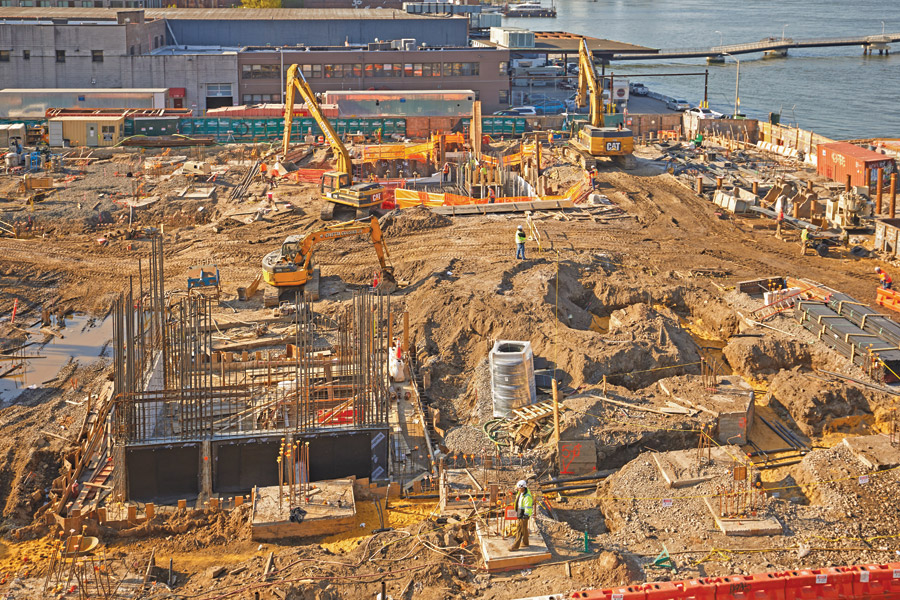
In the geothermal system, horizontal piping 4 ft below grade will connect to the vertical piping loops throughout the site.
Photo by David Joshua Ford, courtesy Lendlease
Fitting In
Connecting to the community, building in storm resilience and strategically locating retail and public spaces were overlapping design challenges, says Marvel partner Dennis Vermeulen.
But the property also offered design solutions, such as being able to flow seamlessly to the waterfront esplanade and ferry pier. Choosing two slender towers over a single skyscraper—with the taller tower set on pilings—also created more ground-level public space, Vermeulen points out. He adds that having five distinct buildings also positions the development to be “more in line with the character of the neighborhood.”
The concept departs from other East River fronting sites dominated by large towers, Walsh says. “From a timing standpoint, it probably would have been more efficient for us to have just built the [Skidmore, Owings & Merrill] design, but as a long-term owner, we really wanted something more connected to the community,” he says.
A prime example is in the six-story structures on the long cross streets, which introduce smaller scale, brownstone-style stoops and familiar exterior materials such as brick. “For that entire length, the public can engage,” Walsh says. “Does this want to feel like a single building, a monolithic design or more like … a neighborhood, a series of buildings? We opted for the latter approach, so each tower has its own material, color and scale of the architectural elements.”
Even the tall towers have a textured precast facade set off with terraces and balconies, Vermeulen says. “We weren’t interested in a cold, glassy building. We wanted warmth and materiality.”
The amenities also acknowledge the pandemic remote-work trend, with conference rooms, an art studio, phone booths, makerspaces, a podcast studio and workspaces that double for fitness or leisure activities, says Jason Jimenez, director at Marvel. “A lot of them are flexible spaces,” he says. “They can be given over to work during the day or recreation in the evenings.”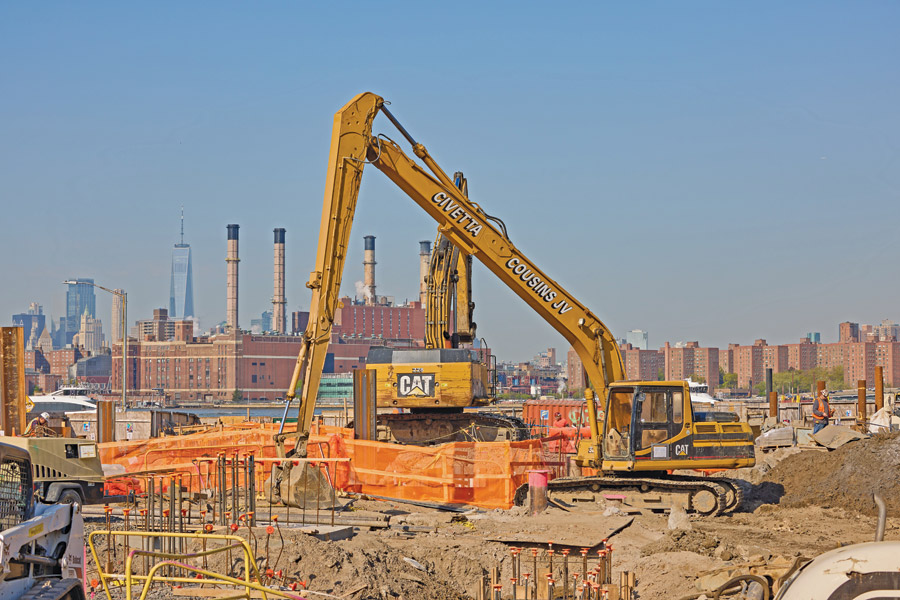
An excavator performs site work on the west side of the 1 Java Street site facing Manhattan.
Photo by David Joshua Ford, courtesy Lendlease
Demolition and Digging
Construction began with demolition of a long vacant warehouse covering the entire site in 2021, followed by brownfield remediation, pile-driving and footing installation last year and, more recently, excavation and geothermal system drilling, Walsh says.
The team went through several iterations to ensure the foundations and geothermal system could co-exist, including horizontal piping 4 ft below grade connecting to the main piping loops down in the bedrock, Fink says. “We played a game underground of everywhere there’s a pile we need to be a certain distance away from it with the geothermal system,” he says. “As building elements shift slightly and the underground coordination changes, we’re constantly relocating and modifying the design.”
As vertical construction begins this summer, the team will use three- or four-day pour cycles on the reinforced concrete structures, depending on the floor, according to Walsh. The low-rise buildings should go up this year, while the taller towers will top out in early 2024, he says.
The smaller structures will have hand-laid brick and some precast, while the towers will mostly have precast panels with factory-installed windows erected by crane. “That’s where the schedule can drastically speed up safely,” Walsh says.
The team is also piloting use of ground-glass pozzolan in the foundation concrete, a mix that avoids carbon-intensive slag cement and fly ash. The option uses readily available recycled glass and can produce a stronger, less permeable concrete.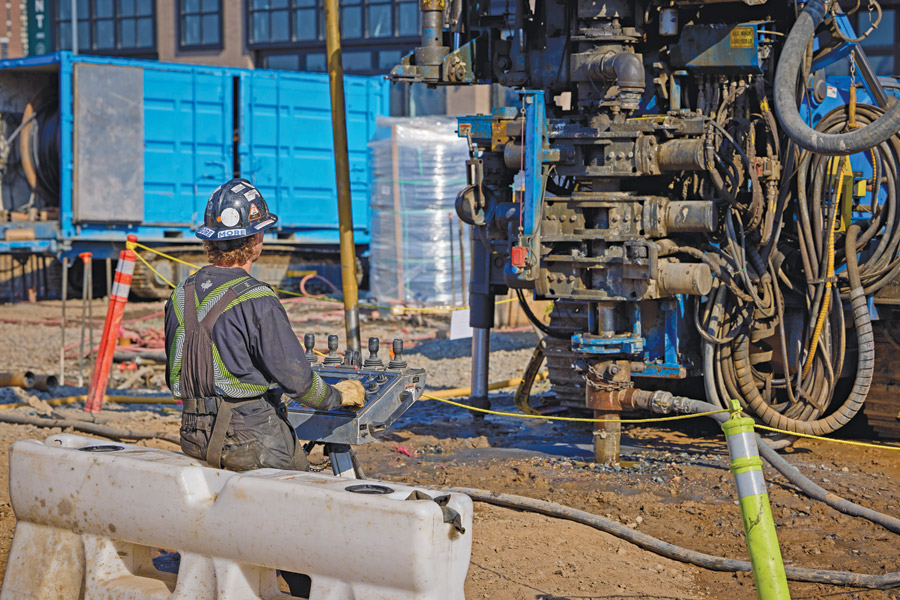
The drilling rigs at 1 Java Street can drill an average of one borehole per day to a depth of 499 ft, the current limit set by state officials.
Photo by David Joshua Ford, courtesy Lendlease
High Point
As the project advances, other sustainability features will come more in focus, including plans to elevate the ground level 6 to 8 ft above the street as the site reaches the river, Vermeulen says.
“This is a ground- breaking project for the U.S., just given its size and complexity.”
—Scott Walsh, New York Project Director, LendLease
Resilience was a critical factor in placing mechanical systems, laying out building footprints and planning foundations, Jimenez says. “You can’t put any program below the floodplain,” he says.
The resilience requirement forced the team to design other ways to welcome the community, Vermeulen says. “That’s a challenge from the public access standpoint because you don’t want to be alienated from the street,” he says. “We used the 8-ft setback along the street to create paths, walkways and some planted areas that get you up to that higher elevation.”
Other sustainable features include 56 electric vehicle spaces and a living shoreline along the esplanade with native coastal plants to help manage water flow from regular tides or flooding events. The design is aiming for LEED Gold, Fitwel and Waterfront Edge Design Guidelines certifications and will meet or exceed New York City’s Local Law 154 all-electric mandate and Local Law 97 carbon emissions limits.
The project ultimately should achieve both its sustainability and community engagement goals, Vermeulen notes. “We feel like we got there,” he says. “That was an exciting trip.”

